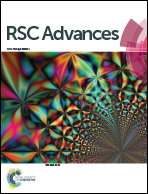In situ TEM observing structural transitions of MoS2 upon sodium insertion and extraction†
Abstract
In this study, the sodiation and desodiation processes of MoS2 were characterized by using an in situ TEM technique. The structural evolution of MoS2 and its performance in a coin-type cell are recognized. Our findings provide a fundamental understanding of the reaction mechanism of MoS2 as anode for Na ion batteries.


 Please wait while we load your content...
Please wait while we load your content...